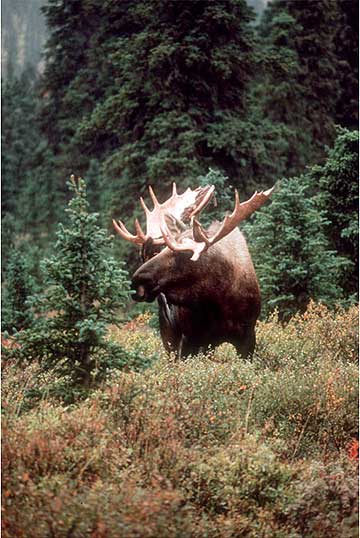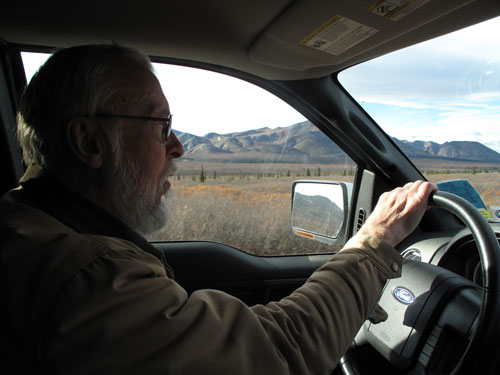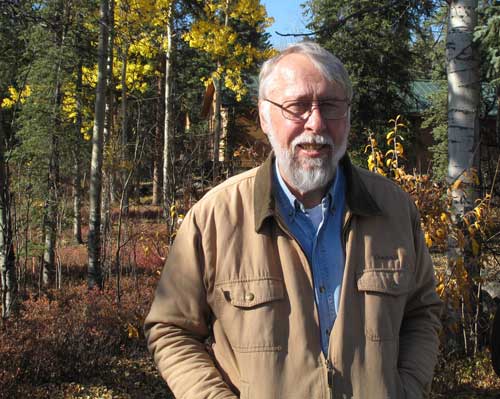
In the company of moose for 32 years
September 28, 2011
“The hunters would love to see him,” Vic Van Ballenberghe says as he pulls his pickup to the side of the park road and grabs his binoculars. “He’s a trophy bull.” The giant moose strolls over a brownish slope that waits for snow. The creature pauses at times, steering with massive antlers one of the cows that orbit him. “He’s got seven with him,” Van Ballenberghe says of a group of blondish female moose. The sight of eight moose is a treat for me, Van Ballenberghe’s guest for the day, but the 67-year old biologist has stood close enough to smell the musk of these moose every spring and fall since 1980. That’s the year he first visited the park and knew he had found the perfect place to study the behavior of this iconic large mammal. He noted how the Denali Park road cuts right through great moose habitat, enabling him to drive within hiking distance to observe them. He saw plenty of moose along the road in 1980, animals that weren’t spooked by people. The bulls were large there, too, in part because the park’s ban on hunting. In 1980, Van Ballenberghe was a biologist with the U.S. Forest Service in Fairbanks. After visiting Denali National Park and Preserve, he wrote a proposal to see if he could make his dream study happen. The staff at Denali Park thought it was a great idea, and the U.S. Forest Service funded the study. Since 1980, Van Ballenberghe has spent more moments in the close proximity of moose than anyone alive. “It’s totaled up to thousands and thousands of hours,” Van Ballenberghe says. Like one of the sandhill cranes croaking overhead on this fall day, Van Ballenberghe has migrated from his home in Anchorage to Denali Park both in spring, when cow moose give birth, and during fall mating season, when dominant bulls gather harems of cows and defend them from other bulls. He retired in 2000, but has continued his study with support from the National Park Service, which provides him an apartment near its headquarters and gives him access to the moose in areas others are not allowed. During the last three decades, Van Ballenberghe and those who have worked with him have cranked out a library of published information about the Denali Park moose, including a nonfiction book, “In the Company of Moose.” Van Ballenberghe and others found that, in some years, eight out of 10 moose calves don’t make it to adulthood, with grizzlies eating half of them and wolves accounting for just 6 percent of calf loss. Van Ballenberghe knows that Denali Park cow moose can live to be 20 (“it’s like a 100-year-old person”) and most of its bulls are gone by the age of 13. He observed a cow that gave birth in almost the exact same spot for 12 consecutive years.
Vic Van Ballenberghe, who has studied moose for three decades, drives the Denali Park road in late September, 2011.
Van Ballenberghe has seen a three-foot September snowfall in 1992 that jumpstarted a winter in which one-third of his collared moose died from starvation. He also remembers 1981, when so little snow fell that he could have driven to Wonder Lake though no one was plowing the road. He has, during three decades, watched spruce trees invade a section of open tundra, and noted the crashes and booms of snowshoe hare and lynx (the latter of which now are more numerous than at any time he can remember). Mostly, he sees and studies moose; sometimes approaching them so close he can hear them breathe. In this era of satellite tracking and circling animals with Super Cubs, he has kept alive what he described in his book as an “old-fashioned, naturalistic approach of directly observing wild animals at close range.” He is critical of Alaska’s predator-control program, claiming that too much emphasis is put on killing wolves and that decision-makers don’t listen enough to scientists. “It took decades to establish science-based wildlife management in Alaska,” he says. “Now all that effort has been lost as politics primarily drives predator control.”
Vic Van Ballenberghe at Denali National Park and Preserve.
On the Denali Park road, after a morning and early afternoon of driving in search of moose, Van Ballenberghe watches the big bull through trusted binoculars that have focused on more moose than probably any other pair in existence. “He’s at least 8 (-years-old), maybe 11 or 12,” he says. “They don’t get that big until fully mature.” Making a mental note of the bull’s location and the number of cows in its harem, Van Ballenberghe sets down his binoculars. The dominant bull, whose genes will live on long after Van Ballenberghe’s time here is done, melts into the brush. One by one, its cows follow, until it seems there are no more moose in the world.
This column is provided as a public service by the Geophysical Institute, University of Alaska Fairbanks, in cooperation with the UAF research community.
E-mail your news &
photos to editor@sitnews.us
|
|||


